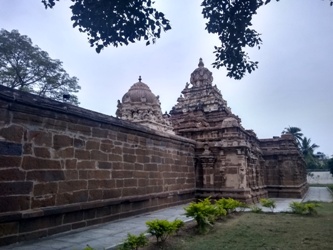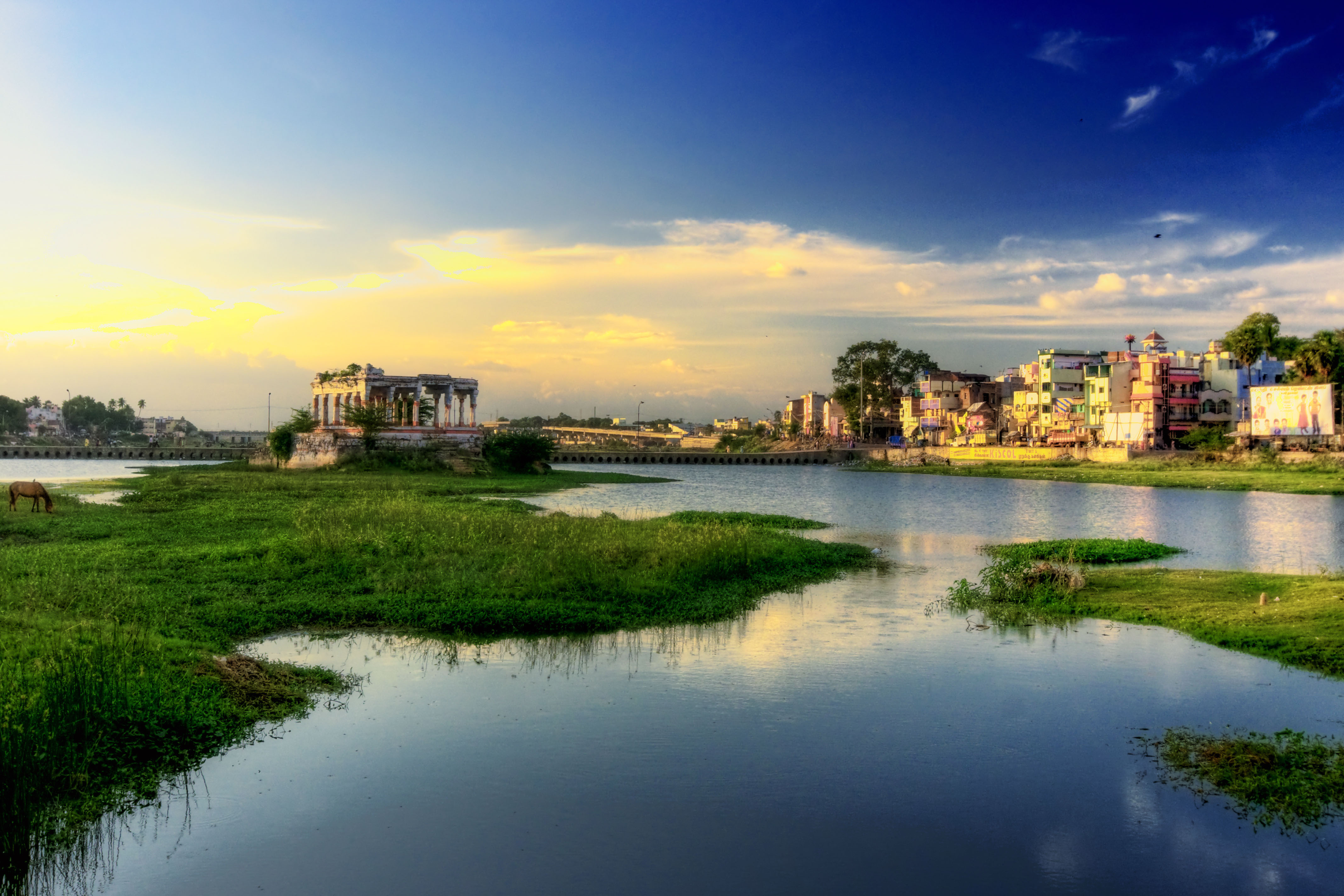|
Nandivarman III
Nandivarman III was an Indian monarch of the Nandivarman II line who ruled the Pallava kingdom from 846 to 869. He was the son of Dantivarman and grandson of Nandivarman II. Reign Nandivarman III, who was a powerful monarch, tried to reverse the decline that began in the reign of his father. He made an alliance with the Rashtrakutas and the Gangas and defeated the Pandyas at the Battle of Tellaru. He then pursued the retreating Pandyan army as far as the river Vaigai. The Pandyan king Srimara Srivallabha, however, recovered most of his territories and even defeated the Pallavas at Kumbakonam. Nandivarman had a powerful navy and maintained trade contacts with Siam Thailand ( ), historically known as Siam () and officially the Kingdom of Thailand, is a country in Southeast Asia, located at the centre of the Indochinese Peninsula, spanning , with a population of almost 70 million. The country is bo ... and Malaya. References * {{Authority control ... [...More Info...] [...Related Items...] OR: [Wikipedia] [Google] [Baidu] |
Pallava Dynasty
The Pallava dynasty existed from 275 CE to 897 CE, ruling a significant portion of the Deccan, also known as Tondaimandalam. The dynasty rose to prominence after the downfall of the Satavahana dynasty, with whom they had formerly served as feudatories. The Pallavas became a major South Indian power during the reign of Mahendravarman I (600–630 CE) and Narasimhavarman I (630–668 CE), and dominated the southern Andhra Region and the northern parts of the Tamil region for about 600 years, until the end of the 9th century. Throughout their reign, they remained in constant conflict with both the Chalukyas of Badami in the north, and the Tamil kingdoms of Chola and Pandyas in the south. The Pallavas were finally defeated by the Chola ruler Aditya I in the 9th century CE. The Pallavas are most noted for their patronage of Hindu temple architecture, the finest example being the Shore Temple, a UNESCO World Heritage Site in Mamallapuram. Kancheepuram served as the capital of the ... [...More Info...] [...Related Items...] OR: [Wikipedia] [Google] [Baidu] |
Dantivarman
Dantivarman was an Indian monarch who ruled the Pallava kingdom from 795 to 846 CE He was the son of Nandivarman II. Reign Dantivarman ruled the Pallava kingdom for 51 years. During his reign, the decline of the kingdom had set in. Pandyan intrusions in the south reduced the Pallava territory to areas in and around Kanchipuram. In 803 CE, the Rashtrakuta king Govinda III defeated him and entered Kanchi Kanchipuram ('; ) also known as ''Conjeevaram,'' is a city in the Indian state of Tamil Nadu in the Tondaimandalam region, from Chennaithe capital of Tamil Nadu. Known as the ''City of Thousand Temples'', Kanchipuram is known for its temple .... Notes References * 9th-century Indian monarchs Pallava kings 846 deaths Year of birth unknown {{India-royal-stub ... [...More Info...] [...Related Items...] OR: [Wikipedia] [Google] [Baidu] |
Aparajitavarman
Aparajita Varman, ( fl. c. 885-903 CE) commonly referred as Aparajita, was a king of the Pallava dynasty. Considered as the last known ruler of the Pallavas, he was defeated and killed in c. 897 CE in a battle against Aditya I. The Pallava dynasty rule at Tondaimandalam came to an end thereafter as the Pallava territories were ceded into the Chola Empire. In 880 CE, Aparajita fought a battle against the Pandya ruler Varagunavarman II and had him defeated. Reign A depiction of Somaskanda on the rear wall of the sanctum of a temple commissioned by him in Tiruttani is regarded as the last known use of that stylistic tradition. In 885 he transferred the rule of Thanjavur to his ally and vassal Aditya I as a reward for his contribution to the victory at Thirupurambiyam. The Cholas The Chola dynasty was a Tamil thalassocratic empire of southern India and one of the longest-ruling dynasties in the history of the world. The earliest datable references to the Chola are fr ... [...More Info...] [...Related Items...] OR: [Wikipedia] [Google] [Baidu] |
Nandivarman II
Nandivarman II (718 CE – 796 CE) was a Pallava ruler who ruled in South India. Sen states Nandivarman reigned from 731 CE – 796 CE and built the Vaikuntha-Perumal Temple. He was born in the country of Champa (modern day Vietnam) into a local dynasty of Pallava origin and was elected as a Pallava king at the age of 13. Background Paramesvaravarman II was succeeded by 12 year old Nandivarman II Pallavamalla who belonged to the collateral line of Pallavas called the Kadavas. The latter were the descendants of Bhimavarman, the brother of Simhavishnu. Hiranyavarman, the father of Nandivarman Pallavamalla is said to have belonged to the Kadavakula in epigraphs. Nandivarman II himself is described as "one who was born to raise the prestige of the Kadava family". He is credited to have built the Tiru Parameswara Vinnagaram. The term ''Kaduvetti'' in Tamil means ''destroyer or clearer of forests'' as the Pallavas like their ancestor Mukkanti Kaduvetti alias Trilochana Pallava ... [...More Info...] [...Related Items...] OR: [Wikipedia] [Google] [Baidu] |
Rashtrakutas
Rashtrakuta (IAST: ') (r. 753-982 CE) was a royal Indian dynasty ruling large parts of the Indian subcontinent between the sixth and 10th centuries. The earliest known Rashtrakuta inscription is a 7th-century copper plate grant detailing their rule from manapur a city in Central or West India. Other ruling Rashtrakuta clans from the same period mentioned in inscriptions were the kings of Achalapur and the rulers of Kannauj. Several controversies exist regarding the origin of these early Rashtrakutas, their native homeland and their language. The Elichpur clan was a feudatory of the Badami Chalukyas, and during the rule of Dantidurga, it overthrew Chalukya Kirtivarman II and went on to build an empire with the Gulbarga region in modern Karnataka as its base. This clan came to be known as the Rashtrakutas of Manyakheta, rising to power in South India in 753 AD. At the same time the Pala Empire, Pala dynasty of Bengal and the Prathihara, Prathihara dynasty of Malwa were gaining ... [...More Info...] [...Related Items...] OR: [Wikipedia] [Google] [Baidu] |
Battle Of Tellaru
The Battle of Tellaru was fought in 830 between the forces of the Pallava King Nandivarman III and the Pandyan King Srimara Srivallabha Srimara Srivallabha (r. c. 815–c. 862 ADSastri, K. A. Nilakanta. (1958, second ed.) ''A History of South India from Prehistoric Times to the Fall of Vijayanagar''. Madras, Oxford University Press. 165.) was a Pandya king of early medieval sou ....Jaques 2007, p. 1005 The Pandyan forces were defeated.Jaques 2007, p. 1005 Notes References * {{Pandya dynasty 9th century in India Pandyan dynasty Pallava dynasty Tellaru ... [...More Info...] [...Related Items...] OR: [Wikipedia] [Google] [Baidu] |
Vaigai
The Vaigai is a river in the Tamil Nadu state of southern India; it passes through the towns of Theni, Dindigul and Madurai. It originates in Varusanadu Hills, the Periyar Plateau of the Western Ghats range, and flows northeast through the Kambam Valley, which lies between the Palani Hills to the north and the Varushanad Hills to the south. The Vattaparai Falls are located on this river. As it rounds the eastern corner of the Varushanad Hills, the river turns southeast, running through the region of Pandya Nadu. Madurai, the largest city in the Pandya Nadu region and its ancient capital, lies on the Vaigai. The river empties into the Palk Bay near Alagankulam, close to Pamban Bridge in Ramanathapuram District. The Vaigai is long, with a drainage basin large. Vaigai Mention Sangam literature (circa 300 BCE to 300 CE) has paid many tributes to Vaigai, extolling it as 'the river that brings water when one touches it', viz the etymology Vai (place your) + gai (hands) = p ... [...More Info...] [...Related Items...] OR: [Wikipedia] [Google] [Baidu] |
Kumbakonam
Kumbakonam (formerly spelt as Coombaconum or Combaconum) or Kudanthai is a city municipal corporation in the Thanjavur district in the States of India, Indian state of Tamil Nadu. It is located from Thanjavur and from Chennai and is the headquarters of the Kumbakonam taluk of Thanjavur district. It is the second largest city in the district after Thanjavur. The city is bounded by two rivers, the Kaveri River to the north and Arasalar River to the south. Kumbakonam is known as a "Temple town" due to the prevalence of a number of Hindu temple, temples here and is noted for its Mahamaham festival, which happens once in 12 years, attracting people from all over the country. Kumbakonam dates back to the Sangam period and was ruled by the Early Cholas, Pallavas, Mutharaiyar dynasty, Medieval Cholas, Later Cholas, Pandyas, the Vijayanagara Empire, Madurai Nayaks, Thanjavur Nayaks and the Thanjavur Marathas. It rose to be a prominent town between the seventh and ninth centuries AD, wh ... [...More Info...] [...Related Items...] OR: [Wikipedia] [Google] [Baidu] |
Siam
Thailand ( ), historically known as Siam () and officially the Kingdom of Thailand, is a country in Southeast Asia, located at the centre of the Mainland Southeast Asia, Indochinese Peninsula, spanning , with a population of almost 70 million. The country is Template:Borders of Thailand, bordered to the north by Myanmar and Laos, to the east by Laos and Cambodia, to the south by the Gulf of Thailand and Malaysia, and to the west by the Andaman Sea and the extremity of Myanmar. Thailand also shares maritime borders with Vietnam to the southeast, and Indonesia and India to the southwest. Bangkok is the nation's capital and largest city. Tai peoples migrated from southwestern China to mainland Southeast Asia from the 11th century. Greater India, Indianised kingdoms such as the Mon kingdoms, Mon, Khmer Empire and Monarchies of Malaysia, Malay states ruled the region, competing with Thai states such as the Kingdoms of Ngoenyang, Sukhothai Kingdom, Sukhothai, Lan Na and Ayuttha ... [...More Info...] [...Related Items...] OR: [Wikipedia] [Google] [Baidu] |
Malay Peninsula
The Malay Peninsula (Malay: ''Semenanjung Tanah Melayu'') is a peninsula in Mainland Southeast Asia. The landmass runs approximately north–south, and at its terminus, it is the southernmost point of the Asian continental mainland. The area contains Peninsular Malaysia, Southern Thailand, and the southernmost tip of Myanmar (Kawthaung). The island country of Singapore also has historical and cultural ties with the region. The indigenous people of the peninsula are the Malays, an Austronesian people. The Titiwangsa Mountains are part of the Tenasserim Hills system and form the backbone of the peninsula and the southernmost section of the central cordillera, which runs from Tibet through the Kra Isthmus, the peninsula's narrowest point, into the Malay Peninsula. The Strait of Malacca separates the Malay Peninsula from the Indonesian island of Sumatra, and the south coast is separated from the island of Singapore by the Straits of Johor. Etymology The Malay term ''Tanah Me ... [...More Info...] [...Related Items...] OR: [Wikipedia] [Google] [Baidu] |




